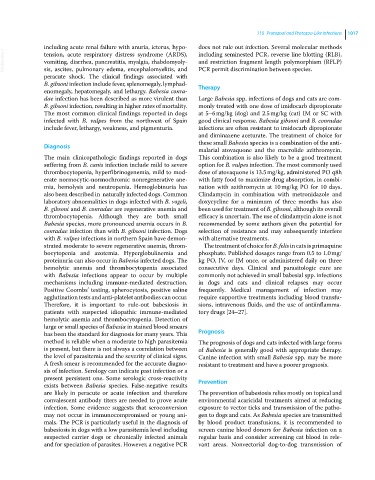Page 1079 - Clinical Small Animal Internal Medicine
P. 1079
110 Protozoal and Protozoa‐Like Infections 1017
including acute renal failure with anuria, icterus, hypo- does not rule out infection. Several molecular methods
VetBooks.ir tension, acute respiratory distress syndrome (ARDS), including seminested PCR, reverse line blotting (RLB),
and restriction fragment length polymorphism (RFLP)
vomiting, diarrhea, pancreatitis, myalgia, rhabdomyoly-
sis, ascites, pulmonary edema, encephalomyelitis, and
peracute shock. The clinical findings associated with PCR permit discrimination between species.
B. gibsoni infection include fever, splenomegaly, lymphad- Therapy
enomegaly, hepatomegaly, and lethargy. Babesia conra-
dae infection has been described as more virulent than Large Babesia spp. infections of dogs and cats are com-
B. gibsoni infection, resulting in higher rates of mortality. monly treated with one dose of imidocarb dipropionate
The most common clinical findings reported in dogs at 5–6 mg/kg (dog) and 2.5 mg/kg (cat) IM or SC with
infected with B. vulpes from the northwest of Spain good clinical response. Babesia gibsoni and B. conradae
include fever, lethargy, weakness, and pigmenturia. infections are often resistant to imidocarb dipropionate
and diminazene aceturate. The treatment of choice for
these small Babesia species is a combination of the anti-
Diagnosis
malarial atovaquone and the macrolide azithromycin.
The main clinicopathologic findings reported in dogs This combination is also likely to be a good treatment
suffering from B. canis infection include mild to severe option for B. vulpes infection. The most commonly used
thrombocytopenia, hyperfibrinogenemia, mild to mod- dose of atovaquone is 13.5 mg/kg, administered PO q8h
erate normocytic-normochromic nonregenerative ane- with fatty food to maximize drug absorption, in combi-
mia, hemolysis and neutropenia. Hemoglobinuria has nation with azithromycin at 10 mg/kg PO for 10 days.
also been described in naturally infected dogs. Common Clindamycin in combination with metronidazole and
laboratory abnormalities in dogs infected with B. vogeli, doxycycline for a minimum of three months has also
B. gibsoni and B. conradae are regenerative anemia and been used for treatment of B. gibsoni, although its overall
thrombocytopenia. Although they are both small efficacy is uncertain. The use of clindamycin alone is not
Babesia species, more pronounced anemia occurs in B. recommended by some authors given the potential for
conradae infection than with B. gibsoni infection. Dogs selection of resistance and may subsequently interfere
with B. vulpes infections in northern Spain have demon- with alternative treatments.
strated moderate to severe regenerative anemia, throm- The treatment of choice for B. felis in cats is primaquine
bocytopenia and azotemia. Hyperglobulinemia and phosphate. Published dosages range from 0.5 to 1.0 mg/
proteinuria can also occur in Babesia infected dogs. The kg PO, IV, or IM once, or administered daily on three
hemolytic anemia and thrombocytopenia associated consecutive days. Clinical and parasitologic cure are
with Babesia infections appear to occur by multiple commonly not achieved in small babesial spp. infections
mechanisms including immune-mediated destruction. in dogs and cats and clinical relapses may occur
Positive Coombs’ testing, spherocytosis, positive saline frequently. Medical management of infection may
agglutination tests and anti-platelet antibodies can occur. require supportive treatments including blood transfu-
Therefore, it is important to rule-out babesiosis in sions, intravenous fluids, and the use of antiinflamma-
patients with suspected idiopathic immune-mediated tory drugs [24–27].
hemolytic anemia and thrombocytopenia. Detection of
large or small species of Babesia in stained blood smears
has been the standard for diagnosis for many years. This Prognosis
method is reliable when a moderate to high parasitemia The prognosis of dogs and cats infected with large forms
is present, but there is not always a correlation between of Babesia is generally good with appropriate therapy.
the level of parasitemia and the severity of clinical signs. Canine infection with small Babesia spp. may be more
A fresh smear is recommended for the accurate diagno- resistant to treatment and have a poorer prognosis.
sis of infection. Serology can indicate past infection or a
present persistent one. Some serologic cross‐reactivity Prevention
exists between Babesia species. False‐negative results
are likely in peracute or acute infection and therefore The prevention of babesiosis relies mostly on topical and
convalescent antibody titers are needed to prove acute environmental acaricidal treatments aimed at reducing
infection. Some evidence suggests that seroconversion exposure to vector ticks and transmission of the patho-
may not occur in immunocompromised or young ani- gen to dogs and cats. As Babesia species are transmitted
mals. The PCR is particularly useful in the diagnosis of by blood product transfusions, it is recommended to
babesiosis in dogs with a low parasitemia level including screen canine blood donors for Babesia infection on a
suspected carrier dogs or chronically infected animals regular basis and consider screening cat blood in rele-
and for speciation of parasites. However, a negative PCR vant areas. Nonvectorial dog‐to‐dog transmission of

